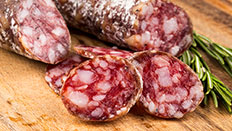Meats and Sausages
Salame di Fabriano
Salami Fabriano comes from Le Marche, an eastern region Italy which sits between the Apennine Mountains and the Adriatic Sea. Salami production was already known in Fabriano, Montefeltro and Ascoli areas in 1600 -1700, and the sausage was made from pork meat only, but now the mixture of pork meat, pork fat and beef are quite common. Meats are ground finely, but the fat is diced into 10 mm (1/2”) cubes to act as show-piece when the sausage is cut. The salt is added at 4%, so to offset the harshness of salt, the sausage is consumed with a locally produced non-salted bread.
| Meats | Metric | US |
|---|---|---|
| Lean pork, well-trimmed | 750 g | 1.65 lb |
| Back fat, diced | 250 g | 0.55 lb |
Ingredients per 1000g (1 kg) of meat
| Salt | 40 g | 7 tsp |
| Pepper, whole | 1.5 g | 1 tsp |
| Pepper, ground | 0.5 g | 1/4 tsp |
| White wine | 5 ml | 1 tsp |
Instructions
- Grind lean meat with 5 mm (3/16”) plate.
- Cut partially frozen fat into 10 mm (3/8”) cubes or grind through 10 mm (3/8”) grinder plate.
- Mix meat, fat and all ingredients together.
- Stuff into pork bungs making 30-35 cm (12-12”) links. Reinforce with butcher twine, making a lengthwise loop and few a few steps across. The sausage can also be stuffed into beef middles.
- The stuffed sausage is conditioned for 1 day at 18° C (64° F), 90% humidity and some air flow.
- Then for about 6 days the sausage is dried from 17° C (63° F) → 14° C (56° F), 88% → 75% humidity, both parameters gradually being lowered every day. The air flow can be decreased, too.
- Then the sausage enters maturing stage at 12-14° C (53 – 56° F), 65-75% humidity that continues for 2 months or longer depending on the diameter of its casing. The final product is covered in white mold.


















